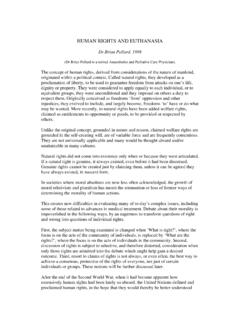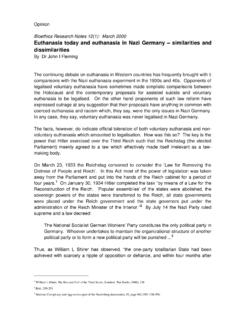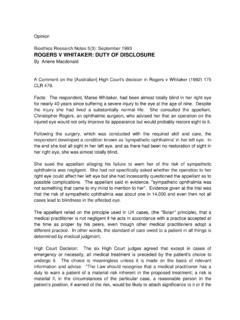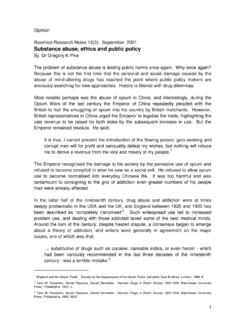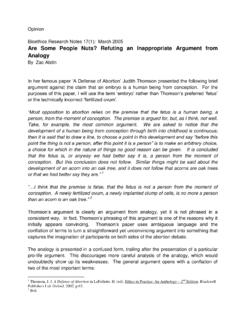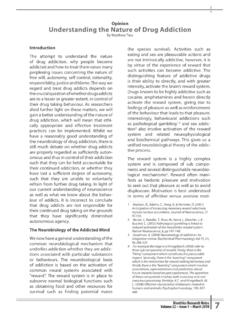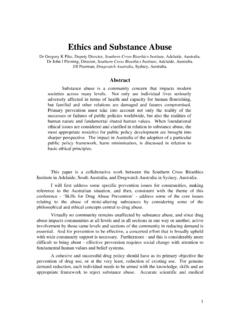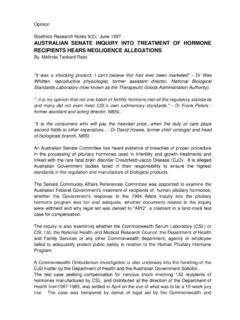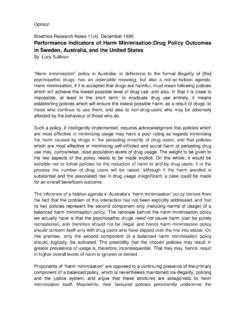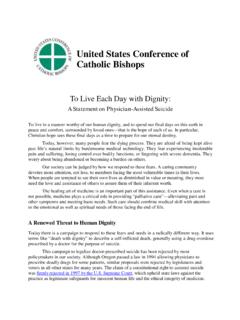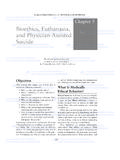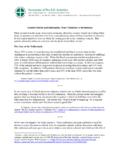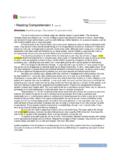Transcription of LEGALISED EUTHANASIA IN AUSTRALIA
1 LEGALISED EUTHANASIA IN AUSTRALIA . AUSTRALIA is the only country in the world where EUTHANASIA has been formally LEGALISED by statute. The Act, known as the Rights of the Terminally Ill Act (ROTI) of the Northern Territory, had a relatively brief history, and its development is of interest. In February 1995, the then Chief Minister of the Northern Territory, Marshall Perron, announced his intention to introduce a bill for voluntary EUTHANASIA into the parliament. As time went on, he was forced to make several changes to the bill and to establish a parliamentary inquiry, which was only given limited terms of reference. The parliament was evenly divided, but in the final, exhausting all-night sitting, the bill passed by a narrow margin on 25 May, 1995. History, of several kinds, had been made. While it was a legal world first, it had taken place in a small, provincial parliament with no house of review, for a community with limited radiotherapy services, no palliative care specialist, an inadequately resourced domiciliary palliative care program and not a single hospice.
2 For over a year, no use could be made of the Act because some of its provisions were found to be unworkable. Eventually, after a failed legal challenge to its validity, the necessary official approval was finally given and it passed into law on July 1, 1996. It contained no local residential requirements, so all Australians had access to it, but neither doctors nor lawyers seemed to be sure of its limits. Meanwhile, in the State of New South Wales, a member of the Labor Party was given leave by his party to introduce a private member's bill for the legalisation of voluntary EUTHANASIA in that State. A low-key organisation, called EUTHANASIA NO', to oppose the moves for EUTHANASIA in NSW, was set up with a young lawyer, Tony Burke, at its head. The then Premier of NSW, Bob Carr, had been an open supporter of EUTHANASIA , but, after further consideration, he gradually changed his view.
3 When the original mover of the bill resigned from parliament, other members of his party wanted to adopt the bill, but were denied. Some other parliamentarians expressed interest in fostering another bill, but nothing came of them. The leaders of both major political parties in NSW publicly declared themselves against LEGALISED EUTHANASIA . In October 1996, two non-parliamentarians with opposing views were invited to address the parliament, a thing that had not occurred in living memory. Tony Burke was one of these. He not only won the debate, he received a standing ovation for what was considered one of the best speeches ever heard in the House. EUTHANASIA became a dead issue in New South Wales, for the time being. Meanwhile, in the national parliament in Canberra, a young lawyer MP, Kevin Andrews, had become appalled at the news that the dormant NT Act was to be put into effect at last.
4 As a lawyer, he knew that the national parliament could override certain laws in the Territories, but not in the States. After some discussions within his party, he was given approval to try to do that. Andrews and Burke met and decided to pool their resources in the national arena. By the time Andrews introduced his bill to overturn the NT Act into the federal parliament on October 28, 1996, the organisation was ready to go. In a newspaper article in June of that year, Andrews had written: Southern Cross Bioethics Institute For more than a decade I have been professionally concerned with death. Through my involvement with the Victorian parliamentary inquiry into dying with dignity in the 1980s and the subsequent debates about appropriate legislation, I came to consider carefully the appropriate balance between rights and responsibilities.
5 The Victorian legislation, which I helped to draft, draws a clear distinction between recognising the right of a person to refuse futile, burdensome or unwanted treatment, and the deliberate active bringing about the death of another person. It was on this basis that I was confident in advising a hospital that it could ethically accede to a patient's request to turn off a ventilator because she found it burdensome. This led to my drafting protocols for hospitals to establish procedures for when a patient should not be resuscitated. The work shaped my personal conviction that the active taking of anther's life is '. Andrews gave as the main reasons for his bill that the NT Act had been passed by a small territory, with the population of a suburban municipality in Melbourne or Sydney, by one vote, without any house of review, without attempting to say why a law rejected by every major inquiry in the world was proper, and in the face of universal opposition from its Aboriginal population', and that it was poorly drafted, had inadequate safeguards and a law that fails to protect innocent people will always be a bad law'.
6 Lawyers everywhere were prominent among those who supported the NT. Act, claiming it was not only safe, but a model of safety. The Andrews bill easily passed in the lower House on December 9, 1996, and just three days later, was sent to the Senate, where members of all parties were allowed a conscience vote. There was a short delay while a Senate Committee reviewed the situation, then, when put to the vote in March 1997, the Bill passed by 38 votes to 33, and with that, the life of the NT statute, which had lasted only eight months, was brought to an end. The Bill's passage was at once followed by an intense and acrimonious outburst of public dismay and criticism. Some accused the politicians of cowardice, of bowing to the religious lobby (though only one sixth of submissions to the Committee had mentioned religious morality), but the most common accusation was that the politicians had either ignored or betrayed the clear wishes of the majority, because public opinion polls were generally believed to reflect mature, reasoned community views on EUTHANASIA .
7 In fact, the Committee had simply reached the same conclusion as every previous similar government-sponsored committee of inquiry into the consequences of legalising EUTHANASIA , anywhere in the world, namely that it was an unsafe law. By contrast, one who had observed the Committee in action said I can express my surprise and relief at the conscientious way in which many of the politicians went about their task of understanding and evaluating the issues, about which, like the community itself, they were at first largely ignorant'. Despite the intensity of the outcries against the apparent betrayal, the furore quickly subsided and has not been heard since, though the underlying mindset of many is of course unchanged and will undoubtedly surface again. In an article written by three Australian authors, published in an English medical journal in 1998, the actual workings of the ROTI Act during the 8 month period of its life were analysed.
8 One of the authors, Philip Nitschke, who was the practitioner who had carried out all four of the acts of EUTHANASIA during that time, supplied all the information about the patients, which could not Southern Cross Bioethics Institute otherwise have been known. In addition to the three patients, another four possible candidates did not avail themselves of the law. Nitschke subsequently repudiated the conclusions of the article, claiming they were unwarranted. Among the article's findings were: - one patient who received EUTHANASIA did not meet the requirements of the Act - differences of opinion arose between doctors over one patient's medical future. It was resolved by a doctor with no expertise in terminal care. - in one case, relevant psychiatric evidence had been withheld. - all seven patients had symptoms of depression.
9 - the requirement of the Act that each patient be seen by a psychiatrist was intended to be a gate- keeper' against the unacceptable possibility that some patients who wanted EUTHANASIA could be successfully treated so that this wish could be overcome. Analysis of the cases showed that depression is difficult to diagnose in the terminally ill (see relevant section of the paper in this series on The Legalisation of EUTHANASIA ), and that the critical function of the psychiatrist and other specialists as gate-keepers' against possible abuse was clearly limited'. In short, the ROTI was not the model of safety that some lawyers had predicted. It was a tragedy that this outcome, that had been foreseen and warned against by numerous committees of inquiry, were not heeded. A critique of the ROTI (drafted before its enactment) is included at the end of this paper as an Appendix, to enable readers to understand better what was actually rejected by the Australian parliament.
10 It is inconceivable that such a law could have survived scrutiny in any other Australian State. Some other developments regarding EUTHANASIA in AUSTRALIA - Altogether, Australian parliaments have, over the years, been presented with many proposals to legislate for EUTHANASIA . None have succeeded. - The South Australian parliament has already rejected one law to allow EUTHANASIA , and is expected to report soon on a further attempt, following the holding of an extensive inquiry. - The Australian Capital Territory parliament has in recent years rejected a bill for EUTHANASIA . - In 1996, the Tasmanian parliament appointed a committee of five MPs to examine the legalisation of EUTHANASIA in that State. Of the five members, four were in favour of EUTHANASIA . After holding a public inquiry, which took written and oral submissions, and after a lengthy period of deliberation, the Chairperson of the committee released its final unanimous report against legalisation in 1998.
